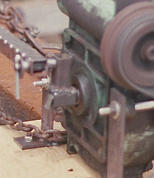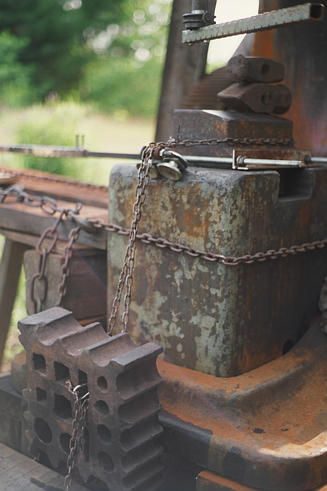

After hours of hand grinding with 4-1/2" and 7" disks and a cup stone, the horrible mess on the anvil surface and dovetail floor was pretty well cleaned up. By luck, the floor of the dovetail came out flat and level to less than 1/32". But the top surface still had enough variation that the die didn't make sufficiently even contact to please me. How about I lap it in?
Couldn't get any coarse lapping compound locally. As second best, I
contact-cemented 50 grit emery cloth to the under side of the die.
Now how to grind that 100# plus die back and forth about a million times?
 Here's the rig. A 3450 RPM, 1/2 HP motor drives a wormgear
box from a mechanical coal stoker. Output is a whopping 6 RPM.
The stoker screw is replaced by a little 2"-throw crank and an
adjustable connecting rod.
Here's the rig. A 3450 RPM, 1/2 HP motor drives a wormgear
box from a mechanical coal stoker. Output is a whopping 6 RPM.
The stoker screw is replaced by a little 2"-throw crank and an
adjustable connecting rod.

The conrod is linked to a clamp that's dogged down firmly on the die.
Motor and gearbox are clamped to planks and sawhorses and the whole
rig is chained to the anvil. The punji cord (with the help of a weight
that's out of sight at bottom) is supposed to keep the die
firmly up against the near side of the dovetail.
 The punji cord didn't do the job. This did. Swage block hangs from a
light chain that runs over a little garage door truck and loops around
the die. Without the truck, the chain dragged and bumped and made the
die track unevenly. With the truck in place and a little grease on the
swage block, the die tracked nicely back and forth. The hammer heads,
added for extra weight, were replaced by a 60# cast iron, flanged
sewer pipe cap.
The punji cord didn't do the job. This did. Swage block hangs from a
light chain that runs over a little garage door truck and loops around
the die. Without the truck, the chain dragged and bumped and made the
die track unevenly. With the truck in place and a little grease on the
swage block, the die tracked nicely back and forth. The hammer heads,
added for extra weight, were replaced by a 60# cast iron, flanged
sewer pipe cap.
Turn the thing on, go do somthing else for a couple-three hours. Then strip off the emery cloth, clean off the cement with a 3M bristle disc and start over. A little oil on the emery cloth seemed to prolong the life of the cloth & abrasive. Three days later I had a much better fit — not perfect but pretty good.
Oh yes: That thing sticking down from the top of the picture is a tool to measure the levelness of the anvil. A piece of 1-1/2"x1-1/2" angle is clamped vertically into the tup bore. With a little fiddling, it self-aligns parallel to the bore axis. A piece of pipe is clamped into the angle and an old VW throwout bearing is shimmed tightly onto the pipe. A piece of thin-wall square is fastened to the bearing with eye-bolts. To get the anvil level, I attached a mag-base dial indicator stand upside down and made a little slide holder for a narrow 6" steel rule in place of the dial indicator itself. With the rule vertical in the slider and one end resting on the anvil, I could swing the arm or move the mag-base along the arm and get good measurements of the anvil surface relative to the tup bore.